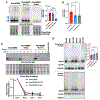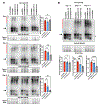Lysine 117 on ataxin-3 modulates toxicity in Drosophila models of Spinocerebellar Ataxia Type 3
- PMID: 37865002
- PMCID: PMC10841544
- DOI: 10.1016/j.jns.2023.120828
Lysine 117 on ataxin-3 modulates toxicity in Drosophila models of Spinocerebellar Ataxia Type 3
Abstract
Ataxin-3 (Atxn3) is a deubiquitinase with a polyglutamine (polyQ) repeat tract whose abnormal expansion causes the neurodegenerative disease, Spinocerebellar Ataxia Type 3 (SCA3; also known as Machado-Joseph Disease). The ubiquitin chain cleavage properties of Atxn3 are enhanced when the enzyme is itself ubiquitinated at lysine (K) at position 117: in vitro, K117-ubiqutinated Atxn3 cleaves poly-ubiquitin markedly more rapidly compared to its unmodified counterpart. How polyQ expansion causes SCA3 remains unclear. To gather insights into the biology of disease of SCA3, here we posited the question: is K117 important for toxicity caused by pathogenic Atxn3? To answer this question, we generated transgenic Drosophila lines that express full-length, human, pathogenic Atxn3 with 80 polyQ with an intact or mutated K117. We found that mutating K117 mildly enhances the toxicity and aggregation of pathogenic Atxn3. An additional transgenic line that expresses Atxn3 without any K residues confirms increased aggregation of pathogenic Atxn3 whose ubiquitination is perturbed. These findings suggest that Atxn3 ubiquitination is a regulatory step of SCA3, in part by modulating its aggregation.
Keywords: Aggregation; Ataxia; Deubiquitinase; Polyglutamine; Ubiquitin.
Copyright © 2023 Elsevier B.V. All rights reserved.
Conflict of interest statement
Declaration of Competing Interest The authors declare that they do not have any conflicts of interest to disclose.
Figures







Update of
-
Lysine 117 on ataxin-3 modulates toxicity in Drosophila models of Spinocerebellar Ataxia Type 3.bioRxiv [Preprint]. 2023 Jun 1:2023.05.30.542896. doi: 10.1101/2023.05.30.542896. bioRxiv. 2023. Update in: J Neurol Sci. 2023 Nov 15;454:120828. doi: 10.1016/j.jns.2023.120828. PMID: 37398109 Free PMC article. Updated. Preprint.
Similar articles
-
Lysine 117 on ataxin-3 modulates toxicity in Drosophila models of Spinocerebellar Ataxia Type 3.bioRxiv [Preprint]. 2023 Jun 1:2023.05.30.542896. doi: 10.1101/2023.05.30.542896. bioRxiv. 2023. Update in: J Neurol Sci. 2023 Nov 15;454:120828. doi: 10.1016/j.jns.2023.120828. PMID: 37398109 Free PMC article. Updated. Preprint.
-
Druggable genome screen identifies new regulators of the abundance and toxicity of ATXN3, the Spinocerebellar Ataxia type 3 disease protein.Neurobiol Dis. 2020 Apr;137:104697. doi: 10.1016/j.nbd.2019.104697. Epub 2019 Nov 26. Neurobiol Dis. 2020. PMID: 31783119 Free PMC article.
-
Ubiquitin-binding site 1 of pathogenic ataxin-3 regulates its toxicity in Drosophila models of Spinocerebellar Ataxia Type 3.Front Neurosci. 2023 Jan 17;16:1112688. doi: 10.3389/fnins.2022.1112688. eCollection 2022. Front Neurosci. 2023. PMID: 36733922 Free PMC article.
-
Toward therapeutic targets for SCA3: Insight into the role of Machado-Joseph disease protein ataxin-3 in misfolded proteins clearance.Prog Neurobiol. 2015 Sep;132:34-58. doi: 10.1016/j.pneurobio.2015.06.004. Epub 2015 Jun 27. Prog Neurobiol. 2015. PMID: 26123252 Review.
-
Toward understanding Machado-Joseph disease.Prog Neurobiol. 2012 May;97(2):239-57. doi: 10.1016/j.pneurobio.2011.11.006. Epub 2011 Nov 23. Prog Neurobiol. 2012. PMID: 22133674 Free PMC article. Review.
Cited by
-
The effect of AKT inhibition in α-synuclein-dependent neurodegeneration.Front Mol Neurosci. 2025 Feb 5;18:1524044. doi: 10.3389/fnmol.2025.1524044. eCollection 2025. Front Mol Neurosci. 2025. PMID: 39974188 Free PMC article.
-
Insights into dentatorubral-pallidoluysian atrophy from a new Drosophila model of disease.Neurobiol Dis. 2025 Apr;207:106834. doi: 10.1016/j.nbd.2025.106834. Epub 2025 Feb 5. Neurobiol Dis. 2025. PMID: 39921111 Free PMC article.
-
The deubiquitinase function of ataxin-3 and its role in the pathogenesis of Machado-Joseph disease and other diseases.Biochem J. 2024 Mar 20;481(6):461-480. doi: 10.1042/BCJ20240017. Biochem J. 2024. PMID: 38497605 Free PMC article. Review.
-
Allosteric Modulation of Pathological Ataxin-3 Aggregation: A Path to Spinocerebellar Ataxia Type-3 Therapies.bioRxiv [Preprint]. 2025 Jan 24:2025.01.22.633970. doi: 10.1101/2025.01.22.633970. bioRxiv. 2025. PMID: 39896516 Free PMC article. Preprint.
References
-
- Brand AH, et al., 1994. Ectopic expression in Drosophila. Methods Cell Biol. 44, 635–54. - PubMed
Publication types
MeSH terms
Substances
Grants and funding
LinkOut - more resources
Full Text Sources
Medical
Molecular Biology Databases

